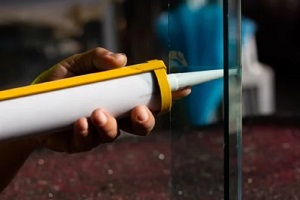 Commercial properties are, on average, larger than residential structures, and with this size comes increased chances of building issues that require repair and regular maintenance. Many commercial building owners will examine their exterior for cracks in masonry, peeling paint or broken gutters, but few think to check the state of the caulk.
Commercial properties are, on average, larger than residential structures, and with this size comes increased chances of building issues that require repair and regular maintenance. Many commercial building owners will examine their exterior for cracks in masonry, peeling paint or broken gutters, but few think to check the state of the caulk.
Without a caulk that is in good condition, a building loses much of its waterproofing capabilities. Here is what you should know about the function of caulk in your building, how to tell if it needs to be replaced and how replacing your Delaware commercial caulking can save you money.
What Is Caulking?
Caulk is a pliable substance that is injected or applied to cracks and gaps in a building. Most commonly, it will be used around windows and doors, as well as in areas in which a vulnerability has been created in a building, such as where a pipe exits the exterior. The purpose of caulk is to seal these gaps so that moisture, pests and other unwanted infiltrators cannot get in.
Caulk is waterproof, but the exact type used on your building may vary. Acrylic and vinyl caulk are common, but silicone caulk may be used in areas in which other types do not adhere properly. Some types cling well to metal, while others do not.
Identifying which type of caulk you have is one factor in the decision to trust caulking repairs to the professionals, as using the wrong type will not create a waterproof seal.
How Replacing Your Delaware Commercial Caulking Can Save You Money
When caulk begins to fail, many issues can arise quickly and cause lasting damage to a structure. Replacing caulking prevents these problems and saves you money on repairs. For example, when caulk no longer creates a waterproof barrier, moisture can infiltrate cracks and gaps. If these are in siding, the moisture can begin to rot the siding from the inside, requiring comprehensive replacement later.
Moisture that creeps into masonry may begin to cultivate mold behind a building’s interior walls, which can require costly remediation. Mold is a problem that most facility owners are not aware of until it becomes severe, and black mold specifically can pose a health hazard to humans.
Caulking does not just save you money by avoiding expensive repairs. It can also reduce your utility bills. When the spaces surrounding windows, doors and exterior gaps are not caulked properly, outside air can creep in. During the summer, hot air infiltrating these cracks requires your AC to work harder to maintain a comfortable temperature.
In winter, your furnace will spend more energy to combat the cold air creeping in through uncaulked vulnerabilities. By properly caulking, you can reduce or eliminate drafts that cost your facility more in energy bills while simultaneously making interior spaces more comfortable and consistent.
How to Tell if Caulking Needs Replacement
Replacing caulk should be part of any building’s maintenance schedule as needed, but how can you tell when the caulk needs to be replaced? The most prominent sign to look for is a caulk that is cracked.
This indicates that the flexible sealing properties of the caulk have degraded, and it has become brittle and dry. This typically causes caulk to pull away from the gap, where it is no longer making a complete seal.
Another obvious sign of decay is when caulk is missing entirely or is uneven. The bumps and waves of an old strip of caulk are showing areas where it is no longer properly attached, and the space underneath is entirely vulnerable to moisture and air intrusion.
Caulk that is discolored is another thing to pay attention to because supple, flexible caulk should be white or off-white (unless it is silicone, which is often clear). Discoloration means that the compounds in the caulk are breaking down, and it is becoming brittle.
Once problematic caulk has been identified, many business owners choose to purchase a tube of caulk from the home improvement store and simply patch the problem area. However, this is not a good idea and will not produce a flush seal.
Old caulk must be removed before new material is applied, and this can be a detailed process that benefits from the expertise of the pros so as not to damage the building during the process.
Leave Caulk Repairs to the Pros for Best Results
Whether you have noticed damaged caulk around your commercial building or you are unsure what to look for and need help, this type of job is best left to the experts. The professionals at Waterproof Caulking & Restoration can identify degrading Delaware commercial caulking and comprehensively address problems, including full replacement if necessary. Contact us to learn more about our commercial services or to schedule an appointment.
